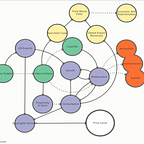Systems Thinking Through: Trickle Down Economics
I haven’t done one of these in a while. My goal is to keep it to a 4 minute Medium read at maximum, so it may not be as comprehensive as my previous rundowns.
To start, what is trickle down? The essence seems to be that we sacrifice emphasis on distributing the metaphorical pie in favor of focusing more on growing the metaphorical pie. A rising tide lifts all boats. (Is it a red flag when simple real life issues are immediately abstracted into multiple metaphors?)
I think this is a fairly uncritical representation of the trickle down worldview. Dotted lines mean inverse relationships remember.
So economic growth is perpetually operating under capacity due to regulation, high capital taxation, and progressive taxation of income. If we cut all three we will “unleash the beast” (another metaphor) of the free market and our true economic growth potential will be revealed.
Let’s start from the top and trickle our way down. The three green elements are obviously the three main elements associated with trickle down.
Regulation is always self-evidently holding back economic growth 100% of the time. That one’s simple.
Capital taxation is also self-evidently holding back economic growth. Cutting it will be good for economic growth, but will lead to inequality. (Which is fine because a rising tide lifts all boats.)
Higher Marginal income tax rates also mean lower inequality. Therefore reducing the progressivity of the income tax system will contribute to more inequality also which is still fine because it will lead to more hard work and more risk taking.
People will work harder because they get to keep more of their money, and they will take more risks because they get to keep the benefits of those risks.
Hard work leads to more economic growth. Risk taking leads to more innovation which leads to more jobs and more economic growth.
More jobs should also lead to an increase in wages, but I rarely see that argument made possibly because it would be too easy to refute. It could also be because the term wages implies someone is paid by the hour whereas in the trickle down mind palace everyone is salaried. (and protestant)
Criticisms:
Right wing criticisms:
- Capital taxation should be linked to innovation
- Regulation should be connected to jobs.
- Elements representing trickle down are not comprehensive. These would be fair in my view.
Left wing criticisms:
- Regulation exists for a reason.
- Trickle down, which is supposed to encourage hard work, seems to punish those who actually earn income from their labor.
“Since its peak of the 1950s, however, the average capital tax rate has been cut by twenty percentage points. At the same time, labor taxation has risen more than ten points, driven by the upsurge in payroll taxes. To capital owners who have prospered, the tax system has given more. From workers whose wages have stagnated, it has taken more.” — Gabriel Zucman TOI 2019
- Inequality matters.
- As Ha Joon Chang pointed out trickle down makes the rich richer to make them work harder, while also making the poor poorer for the same reason.
- It could be argued that a strong welfare state would also benefit risk taking and innovation since risks could be taken by people who aren’t already economically secure. (An ever declining population)
- And most importantly the presupposition that regulation, capital taxation, and marginal tax rates are restraining economic growth has now had four decades of empirical refutation.
“From the vantage point of 2019, the effects of Reagan’s reforms seem quite dubious. Growth of per capita national income fell by half in the three decades following Reagan’s term (compared with the previous three or four decades). Since the goal of the reforms was to boost productivity and growth, this can hardly be counted a satisfactory outcome. In addition, inequality skyrocketed, so much so that the bottom 50 percent of the income distribution has seen no income growth since the early 1980s, which is totally unprecedented in US history (and fairly uncommon for any country in peacetime). And yet the Democratic presidents who followed Reagan, Bill Clinton (1992–2000) and Barack Obama (2008–2016), never made any real attempt to revise the narrative or reverse the policies of the 1980s.”
Does Trickle Down Work?
I don’t like how these questions are posed. How can such a complex sweeping change in political economy be classified into a binary question? I would argue trickle down works for who it is supposed to work for. It was a return to normalcy after the post war 30 year “gentleman’s agreement” of Keynesianism as Naomi Klein dubbed it.
The only reason this agreement lasted as long as it did was because this period’s economic stability and success made it hard for ideological alternatives to gain credibility. When a crisis finally occurred in the form of stagflation, this ideological space was generated and filled by what we now refer to broadly as neoliberal economics.
In Gabriel Zucman’s Triumph of injustice on page 162 he notes that from 1946–1980 the top 1% of earners’ income actually grew slower than every other income group, and slower than the economy as a whole.
This equitable growth is a remarkable departure from the vast majority of capitalist history around the world as described in Piketty’s Capital in the 21st Century. It was brought about by a specific set of circumstances in the Great Depression, a World War, and a global communist threat. There is no reason to think this period of shared prosperity would last forever, nor that it will return anytime soon.
PS I’m still researching the Chinese Political Economy off and on, but still don’t feel qualified to write much about it. The best introduction I’ve come across is Samir Amin’s article from 2013.
